Trees of the Adirondacks:
Tamarack (Larix laricina)
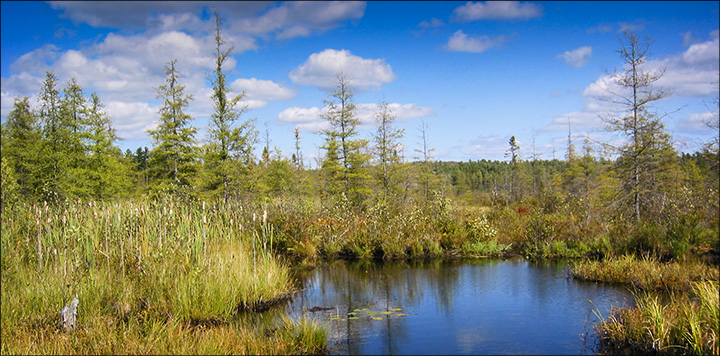 Trees of the Adirondacks: Tamaracks on Heron Marsh from the Heron Marsh Trail boardwalk (19 September 2004)
Trees of the Adirondacks: Tamaracks on Heron Marsh from the Heron Marsh Trail boardwalk (19 September 2004)
| This page is no longer being updated. For an updated and expanded version of this material, see: Tamarack (Larix laricina) . |
The Tamarack (Larix laricina) is a deciduous conifer which flourishes in the Adirondack Mountains, especially in wetlands. It is also referred to as the American Larch, Eastern Larch, Alaska Larch, North American Black Larch, and Hackmatack. Sources differ on the etymology of the latter name; most sources suggest that the name "Hackmatack" derives from the Abenaki word for a kind of supple wood used for making snowshoes.
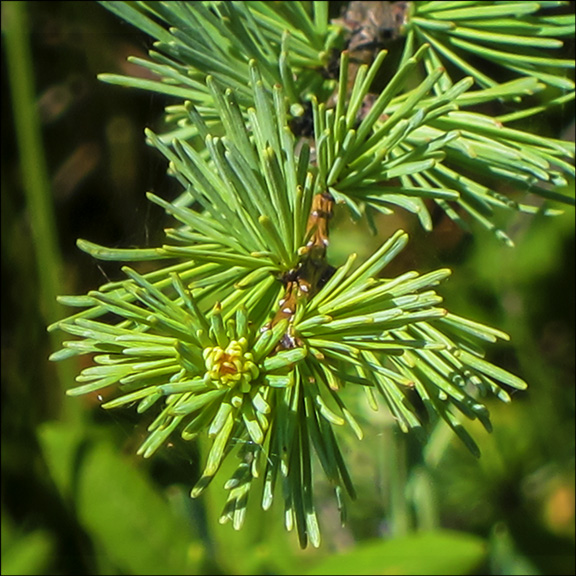
Identification of the Tamarack: A member of the Pine Family, the Tamarack is a slender-trunked, conical tree, with green deciduous needles, about one inch long. The needles of the Tamarack are produced in clusters of ten to twenty. They are attached to the twigs in tight spirals around short spur branches. giving the tree a feathery look.
In contrast to most conifers, which retain their needles all year around, the Tamarack sheds its needles every year in the fall. The glossy needles appear in soft tufts in spring and are initially apple green in color, changing to blue-green as the season progresses. In late summer and early fall, the needles gradually change to a golden color and are then shed.
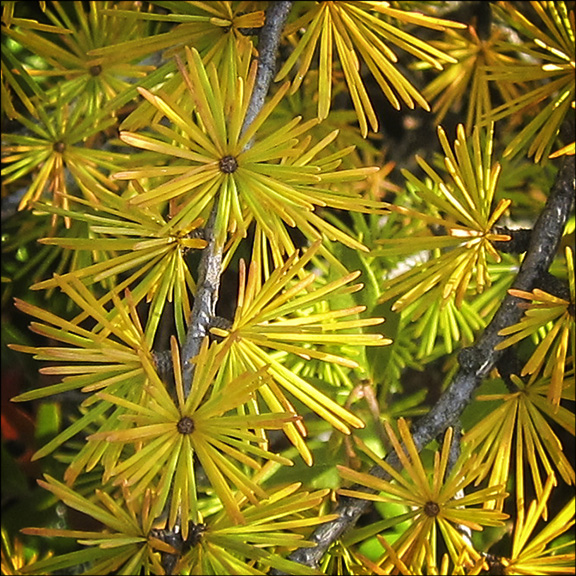
The bark of the Tamarack is gray and smooth when the tree is young, becoming reddish brown and scaly as the tree matures. The inner layer is red-purple. The branches are horizontal or slightly ascending. The twigs are orange-brown, the buds are dark red. The trees are self-pruning.
The seed cones of the Tamarack are small (0.5 to 0.75 inches long), with lustrous brown scales. They are bright red, turning brown and opening to release seeds when mature.
The average height of mature Tamaracks is 50 to 75 feet. However, most Tamaracks growing in bogs and marshes are much smaller, due to the low nutrients available in these locations. Tamaracks growing in peat-lands grow very slowly. A tree that stands only six feet tall may be over a half-century old.
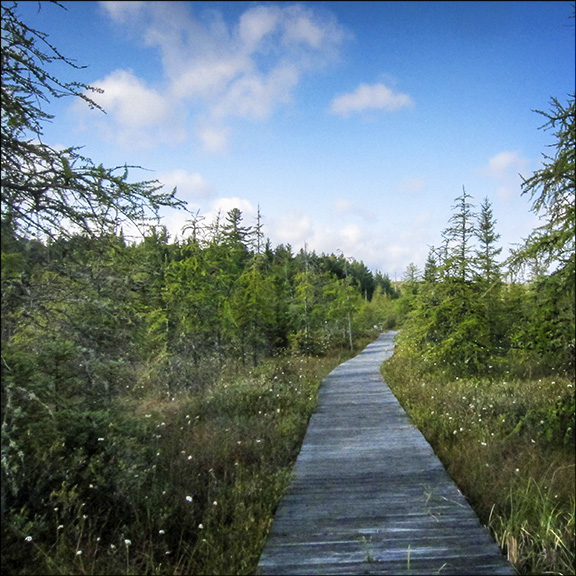
Uses of the Tamarack: The commercial value of wood from the Tamarack is limited due to insect and disease problems. The wood is used mainly for pulpwood, especially in making the transparent paper in window envelopes. Because the wood is relatively rot-resistant, it is also used for posts, poles, mine timbers, and railroad ties. Tamarack is also used in other wood products, including rough lumber, boxes, crates, boats, and fuel wood. The bark contains a tannin which has been used for tanning leather. In Alaska, young Tamarack stems are used for dog sled runners, boat ribs, and fish traps. In earlier periods, native Americans used the fine roots of the Tamarack to sew birch bark and the wood to make arrow shafts.
The plant has limited edible uses. The needles are said to be edible and can be used to make tea. Tea can also be made from the roots. The tender new shoots of the Tamarack reportedly can be boiled and eaten in an emergency.
This plant reportedly was employed medicinally by many native American tribes. For example, the Abnaki reportedly used an infusion of the bark and roots for persistent coughs. The Algonquin made a cough medicine of its needles and inner park. They also applied a poultice of the needles and inner bark to infections and made an infusion of its young branches as a laxative. The Chippewa used a poultice of chopped inner bark to treat burns.
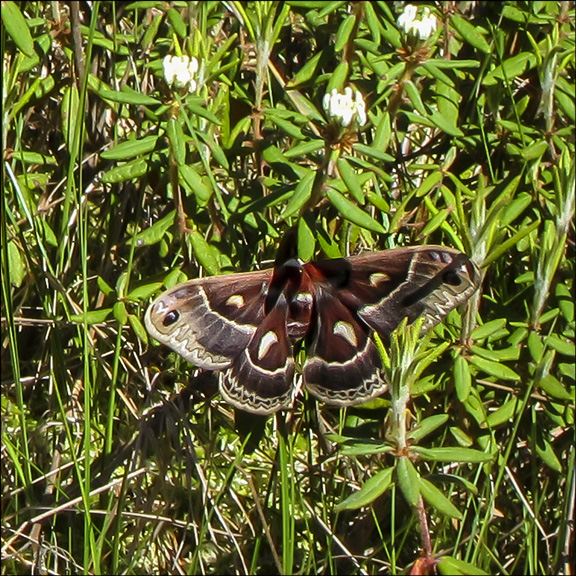
Wildlife Value of the Tamarack: Tamarack is a food source for a few wildlife species. Snowshoe hares browse on Tamarack seedlings. Porcupines feed on the inner bark. Red squirrels eat the seeds. Moose and White-tailed Deer generally avoid Tamarack. This plant is a larval host for the Columbia Silkmoth. In fact, the Columbia Silkmoth larva is known as the Larch Silkworm.
A number of boreal birds use Tamaracks as nesting sites. These include:
- Lincoln's Sparrow
- Black-backed Woodpecker
- Palm Warbler
- Ruby-crowned Kinglet
- Blackpoll Warbler
- Nashville Warbler
- Alder Flycatcher
The seeds of the Tamarack are a favorite of cross bills; the buds are eaten by Spruce Grouse.
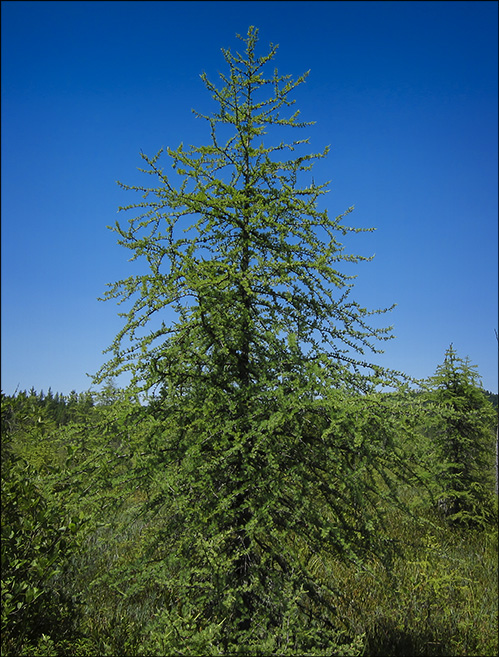
Distribution of the Tamarack: The Tamarack has one of the widest ranges of all North American conifers. Its range extends from Newfoundland and Labrador in Canada, west across the Continental Divide to the northern Yukon. In the US, the Tamarack's range includes Maine, upstate New York (including the Adirondacks), Minnesota, and Wisconsin.
The Tamarack is one of the indicator plants of the boreal forest – the "Spruce-Moose" forest of conifers. It is also an indicator plant of the Boreal Bog. Tamaracks are most commonly found on cold, wet to moist, poorly drained sites, such as swamps and bogs. These trees also grow along streams, lakes, ponds, swamps, and occasionally on upland sites. Tamaracks can tolerate a wide range of soil conditions, but are most commonly found on nutrient-poor, acid peat-lands, often in the same area as Black Spruce.
The Tamarack is one of the most cold-hardy native trees. It is intolerant of shade, heat, and polluted areas. Because the Tamarack can withstand high soil moisture, high acidity, and low soil temperature, the tree is more abundant on peat lands than trees which dominate the surrounding uplands.
The Tamarack is a pioneer tree, especially on open unburned bogs and burned organic soil. It is generally the first forest tree to invade filled-lake bogs and burned sites in boreal forests. However, it is later overtaken in succession by Black Spruce and various other species.
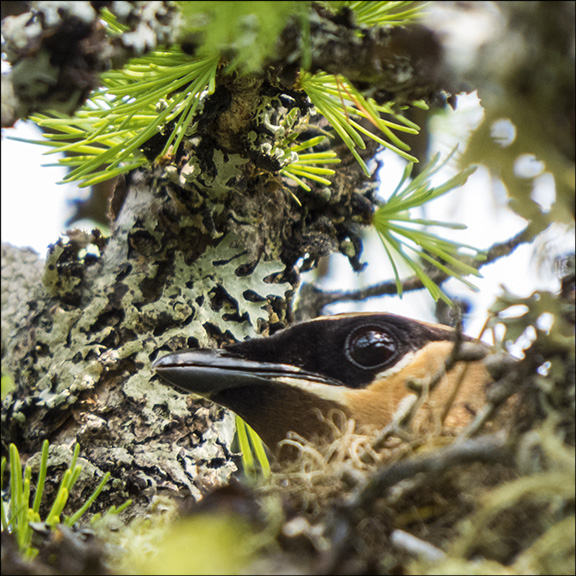
Tamaracks at the Paul Smiths VIC: Tamaracks are widely dispersed on the VIC property, especially in wetland areas. The most convenient places to observe these trees and the associated wildlife, wildflowers, and shrubs are trails which provide access to Heron Marsh and Barnum Bog. The Heron Marsh Trail skirts the edges of Heron Marsh. The 900-foot boardwalk across Heron Marsh and Barnum Brook on the western side of the loop provide views of Tamarack stands on the marsh. Tamaracks growing on the edges of the marsh can also be viewed from the overlooks on the Barnum Brook Trail. There are also Tamaracks near the floating bridge on the Woods and Waters Trail. Tamaracks can also be observed from the overlook on the Jenkin's Mountain Trail and on north side of the Logger's Loop Trail, in the marshy area where Barnum Brook intersects with the trail. Tamaracks growing on the margins of Long Pond can be viewed from the Long Pond Trail.
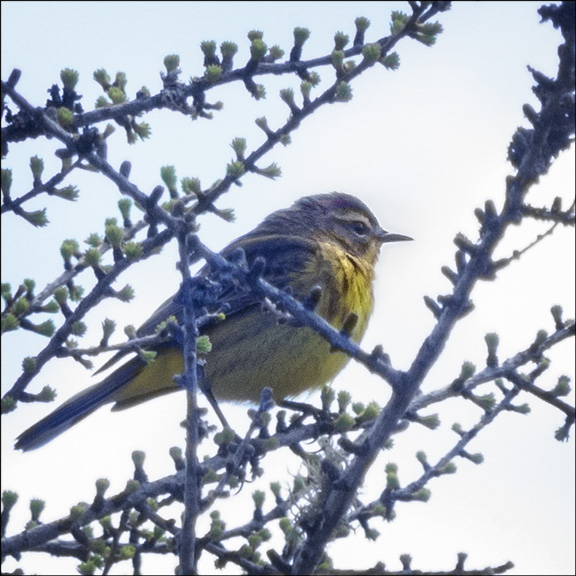
The Boreal Life Trail boardwalk, providing access to Barnum Bog, is the best place to observe Tamaracks on a boreal bog. Here, Tamaracks co-exist with Black Spruce and a host of bog-dwelling shrubs, such as Sheep Laurel, Bog Laurel, Leatherleaf, Bog Rosemary, and Labrador Tea, plus plants which thrive in the sphagnum moss, such as Roundleaf Sundew, Pitcher Plant, Buckbean, Rose Pogonia, and White-fringed Orchid.
Several species of birds are often seen perching on or near the Tamaracks on Barnum Bog, including Yellow-bellied Flycatchers, Cedar Waxwings, and Yellow-rumped Warblers. Palm Warblers and Lincoln's Sparrows are known to nest on Barnum Bog and are often seen and heard here.
References
- United States Department of Agriculture. Forest Service. Silvics of North America. Tamarack. Retrieved 11 January 2015.
- United States Department of Agriculture. Plants Database. Retrieved 11 January 2015.
- Lady Bird Johnson Wildflower Center. Native Plant Database. Retrieved 11 January 2015.
- University of Wisconsin. Trees of Wisconsin. Larix larisina. Retrieved 11 January 2015.
- Flora of North America. Plant Database. Retrieved 11 January 2015.
- Online Encyclopedia of Life. Larix larisina. Retrieved 11 January 2015.
- University of Wisconsin. Robert W. Freckmann Herbarium. Retrieved 11 January 2015.
- New York Flora Association. New York Flora Atlas. Retrieved 11 January 2015.
- University of Michigan. Native American Ethnobotany. A Database of Foods, Drugs, Dyes and Fibers of Native American Peoples, Derived from Plants. Retrieved 11 January 2015.
- Plants for a Future. Database. Retrieved 11 January 2015.
- Online Etymology Dictionary. Tamarack. Retrieved 12 January 2015.
- The Birds of North America. Ruby-crowned Kinglet; Palm Warbler; Lincoln's Sparrow; Black-backed Woodpecker; Nashville Warbler; Alder Flycatcher. Subscription Web Site. Retrieved 12 January 2015.
- Trees of the Northern Forest Trail Walk
- Paul Smith’s College VIC. Barnum Brook Tree Game.
- Michael Wojtech. Bark: A Field Guide to Trees of the Northeast (UPNE, 2011).
- George A. Petrides. A Field Guide to Eastern Trees (Boston: Houghton Mifflin Company, 1998), pp. 34-35, 157.
- John Kricher. A Field Guide to Eastern Forests. North America (Boston: Houghton Mifflin, 1998), pp. 62-70, 122.
